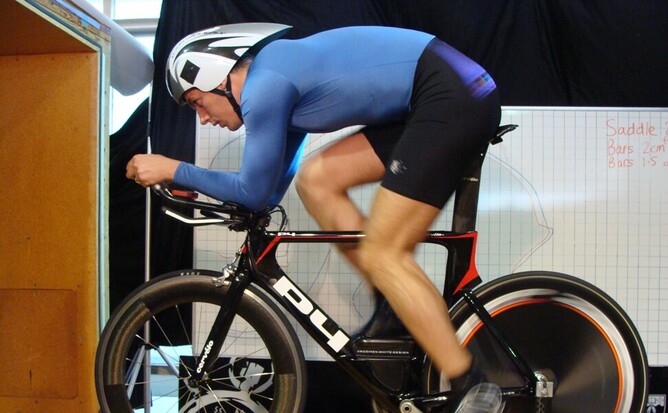Every Aero geeks dream is access to a windtunnel. Recently I was able to spend time in the tunnel again, but this time I got to take my own bike as well rather than just managing the session for others.
I learned a few interesting things, some of which I’ll now share.
Though first I should provide some details of the setup. The tunnel is in the University of Canterbury (in Christchurch, NZ) Engineering department. They actually have three, this is the largest of them and is open. The smaller versions are closed loop and one can generate supersonic speeds.
The large tunnel used for bike testing is set at zero yaw and clamps the bike with two upright arms to the rear skewer. I spent two hours on testing for my own purposes and 6 on testing others.
After establishing the drag for my baseline position I went straight into verifying something that I’d already field-tested. Namely, that 20cm of drop from saddle to pads is a magic number for me. I moved the saddle and bars forward by 2cm and lowered the bars by 1.5cm. There was no point in testing the extra drop in isolation as I’ve already determined that I lose too much power at the resultant hip angle. So I moved to a position that would allow that level of drop without compromising the engine.
This change reduced my CdA (aero drag) by 3.2%, a speed improvement just shy of 1s per km.
Incidentally, this change was an abandonment of UCI legal positioning, though still within the bounds of what I could achieve with a snub nosed saddle.
While I was experimenting with position I tested both wider elbow pads and uptilted forearms (the Mantis position). Both changes made me slower by ~0.5s per km each.
On the equipment side one of the experiments was testing the only other helmet I could find that fits on my fat head – the Giro Advantage.
This change was not positive. I gained back nearly all I’d lost with the first position change. For me, the Advantage is ~0.8s slower over 1km than the Rocket.
Needless to say, I have not rushed out to buy an Advantage.
Helmets were something that I tested with my other athletes too. Of interest is that for one of them the Spiuk Kronos was 1s per km faster than the Uvex FP2 while for another the FP2 was a shade faster than the Kronos.
My theory on this is that the underside of the tail of the Kronos is tapered where the FP2 is squared off. So for the rider whose head was in front of their torso this lead to the tail sticking in the air and thus nasty wake effects from the sharp corners on the FP2, while the Kronos with its smoother shaping was a lot more tolerant of tail up.
For the other rider whose head was above their shoulders the longer, narrower shape of the Uvex won out as the orientation of the helmet did not allow the shaping of the helmet underside to have an effect.
Overall it was a good day that mixed verification of the validity of previous field testing results with some new information (like the helmets). And as a bonus my Clincher disc tested considerably faster than the Tubular version – exonerating one of my pricier purchases.

